The Skull and Bones
 The Skull & Bones Society has been described as the most secretive organization in the world.
The Skull & Bones Society has been described as the most secretive organization in the world.
The origin of the Skull & Bones in the U.S. begins at Yale when a group of men established an organization for the purpose of drug smuggling. Indeed, many American and European fortunes were built on the China (opium) trade. [The Secret Origins of Skull & Bones] It still exists today only at Yale and has evolved into more an organization dedicated to the success of it's members after leaving the collegiate world. The shape of that success can only be left to speculation.  Some of the world's most famous and powerful men alive today are "bonesmen," including George Bush, John Kerry, Nicholas Brady, and William F. Buckley. Other bonesmen include Henry Luce (Time-Life), Harold Stanley (founder of Morgan Stanley), John Daniels (founder of Archer Daniels Midland), Henry P. Davison (senior partner Morgan Guaranty Trust), Pierre Jay (first chairman of the Federal Reserve Bank of New York), Artemus Gates (President of New York Trust Company, Union Pacific, TIME, Boeing Company), Senator John Chaffe, Russell W. Davenport (editor Fortune Magazine), and many others. All have taken a solemn vow of secrecy.
Some of the world's most famous and powerful men alive today are "bonesmen," including George Bush, John Kerry, Nicholas Brady, and William F. Buckley. Other bonesmen include Henry Luce (Time-Life), Harold Stanley (founder of Morgan Stanley), John Daniels (founder of Archer Daniels Midland), Henry P. Davison (senior partner Morgan Guaranty Trust), Pierre Jay (first chairman of the Federal Reserve Bank of New York), Artemus Gates (President of New York Trust Company, Union Pacific, TIME, Boeing Company), Senator John Chaffe, Russell W. Davenport (editor Fortune Magazine), and many others. All have taken a solemn vow of secrecy.
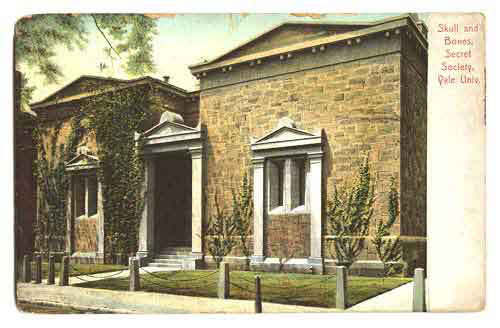
What A Long Strange Trip It's Been
" . . . these same secret societies are behind it all," my father said. Now, Dad had never spoken much about his work. You see, my Daddy was a — spy. He entered into the "intel" world in the late thirties, later, he was OSS and G-2. During the early fifties he was the CIA's Branch Chief, Head of East Asia Intelligence Analyst Office. I spoke Dutch and Malay before English, whilst my family accompanied my "businessman" father to Indonesia in the early 1950s. That my father had worked for the government was no secret, but it just wasn't everyday conversation. So one day, when my dad sat me down, I had very little to relate to when he very soberly and in rapid succession told me, "the Vietnam War is about drugs" and "these secret societies are behind it." He then really laid one on me. "Communism is all a sham, these same secret societies are behind it all." "Hunh???" I really couldn't relate. The only "secret society" I knew of was the Mafia and my teachers had been stuffing me under desks because the "commies" were going to bomb us. And since it was the sixties—and I was a teenager with my hair growing longer—I just tossed it off as my dad's way of having an anti-drug chat and went on with life. Many years later I finally had some understanding of what my dad was talking about and—boy—do I wish I had asked some questions. Like, was he was talking about The Order of Skull and Bones? 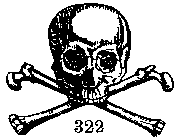 Skull and Bones, the pirates flag, a poison warning—an icon of death—an interesting symbol for what some say is merely a Yale 'frat' club. Just some college kids and their bizarre hazing humor—having fun. For almost 170 years that grimacing visage and code of "strict secrecy" has fostered many questions.
Skull and Bones, the pirates flag, a poison warning—an icon of death—an interesting symbol for what some say is merely a Yale 'frat' club. Just some college kids and their bizarre hazing humor—having fun. For almost 170 years that grimacing visage and code of "strict secrecy" has fostered many questions.
What is Skull and Bones?
The Order of Skull and Bones is the oldest of several senior secret societies that are unique to Yale University. The "Order" was founded in 1832 by William Huntington Russell and Alphonso Taft. Many historians claim the group appeared as a direct result of the de-secretizing of America's oldest Greek-letter college secret society, Phi Beta Kappa. Phi Beta Kappa had been "founded with impressive ritual and high solemnity" on Thursday, Dec 5, 1776, at William and Mary College, in Williamsburg, Virginia. A few years later in April of 1780, at Goshen, Connecticut, four students were "initiated into Phi Beta Kappa." Later on November 13, the official foundation meeting was held at Yale. "Three weeks and a day later" the chapter at William and Mary came to "an end" due to the threat of a British invasion during the War of Independence. Thus making the group at Yale the oldest existent chapter. New England was going through a transformation from the strict puritanical Calvinist outlooks toward a more secular, scientific worldview. The revolutionary fervor and factionalization of the War of Independence had been sandwiched between a series of religious revivals that swept through the countryside like wildfires. During the first years of our Republic there was a big Illuminati conspiracy scare and a generation later an anti-Masonic hysteria that developed into a political force. The first national party convention—by any party, in the US—was held by the Anti-Mason party, in 1832. Many people, including, John Quincy Adams, who was elected to Congress on an Anti-Mason/Whig ticket, were publicly campaigning against the secrecy of Phi Beta Kappa. Phi Beta Kappa dropped its secret society aspect in 1832 and became an "open honorary organization," and "[in] protest, apparently, William H. Russell, valedictorian of 1833, got Alphonso Taft and thirteen other members of '33 to form what is now perhaps the most famous secret society in the United States." From the very beginning Skull and Bones encountered resentment from fellow students. The faculty sent warning letters to the parents of early initiates. Even amid this controversy the chapter persisted and flourished, and by 1884 two other senior secret societies at Yale had been formed: Scroll and Key, and Wolf's Head. Also, Phi Beta Kappa had been revived after disappearing in 1871. One old Yale tradition is "that 'Bones’ is a branch of a university corps of Germany, in which country, General Russell spent some time before graduation." During an infamous break-in by the "Order of File and Claw", on September 29, 1876 into the "Tomb"—the windowless "Bones"-owned and -built meeting house—the walls were seen to be "adorned with pictures of the founders of Bones at Yale, and of the members of the society in Germany, when the Chapter was established here in 1832." In the cellar, the "File and Claw" raiders found a small room, with an "always-burning lamp" and "a dilapidated human skull." Upstairs three rooms were found, a lodge room with its walls covered in black velvet, a table with skull and crossbones, and the "sanctum sanctorum," room number 322, "furnished in red velvet" and on the wall a star with a finger pointing to it. The "Order of File and Claw" also reported "an old engraving representing an open burial vault, in which on a stone slab, rest four human skulls, grouped around a fool's-cap and bells, an open book, several mathematical instruments, a beggar's scrip, and a royal crown. On the arched wall above the vault are the explanatory words, in Roman letters, 'We War Der Thor, Wer Weiser, We Bettler Oder Kaiser?' and below the vault is engraved, in German characters, the sentence; 'Ob Arm, Ob Beich, im Tode gleich,''. "Who was the fool, who the wise man, beggar or king? Whether poor or rich, all's the same in death." This closely resembles the initiation into the Degree of Regent for the Bavarian Illuminati. "This degree was conferred only on such persons as by high intellectual attainments, social position, and tried fidelity, were considered capable of advancing the objects of the Order. The place of reception consisted of three rooms." One of these room was "hung with red," the "first room was set aside for preparation; it was hung with black, and in its centre, on a platform, stood a complete human skeleton, at whose feet, lay a crown and a sword. The candidate was led into this room; his hands were manacled, and he was left alone for a little while, during which time be could hear the conversation: carried on in the middle room. Who has brought this slave hither?—He came and knocked. What does he seek?—Freedom; he beseeches you to free him from his bonds.' Why does he not apply to those who have bound him?—They will not set him free; his servitude benefits them. Who has made him a slave?—Society, the State, false Religion. . . . Does he respect persons? Ask him who was the man whose skeleton be sees before him; was he a king, nobleman, or beggar?—He does not know; he only knows, that he was a man like one of ourselves. He wants only to be a man. Then let him be introduced. The candidate was then brought into the middle, and finally into the last room, and after some more catechising, invested with the dress of the Regent."
Is Skull and Bones an Illuminati group?
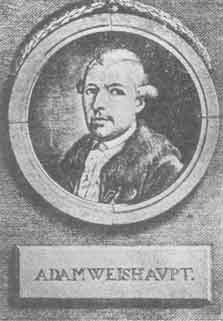
Some historians dispute any link between the Bavarian Illuminati and Phi Beta Kappa, and thus Skull and Bones. The argument is that Adam Weishaupt didn't form his group until May of 1776 and that in the ensuing six months there wasn't enough time for communication and that there was very "little in common between the Bavarian philosopher and the five boys" whom founded Phi Beta Kappa. However, other researchers assert quite plainly that Phi Beta Kappa is the "Bavarian Illuminati, ... spread to America"; and "the Masonic Order probably influenced the founding of the Society at William and Mary." In the late 1700s, ocean travel between Europe and America required a two to three month journey. It has been reported that Weishaupt began "canvassing" members for his order in 1774. He was a zealous member of the Lodge of Eclectic Masonry in 1775,—The Lodge Theodore of Good Consul,—along with people who became members of the Bavarian Illuminati. And even though, the sect was suppressed by the Bavarian government in 1788, there are accounts of the Illuminati's survival. Weishaupt, himself, lived until November 1830. Many of the Illuminati's early members were drawn from the charismatic professor's fellows and students. Weishaupt himself stated: "The first task of the Association must therefore be to form the young members. As these multiply and advance, they become the apostles of beneficence, and the work is now on foot, and advances with a speed encreasing[sic] every day. The slightest observation shows that nothing will so much contribute to increase the zeal of the members as secret union." There had been other secret, semi-secret and open college societies before Phi Beta Kappa, but these had usually had Latin names. The "five boys" who started Phi Beta Kappa were unknown for many years and the main founder was known as just the "young 'Hellenist."" Weishaupt—who rebelled against the Jesuit, Roman Catholic, Latin-speaking "power-structure" of his day—had a great fondness of things "Greek." In the Illuminati he went by Spartacus, the Greek slave who led the revolt against the Romans. All Illuminati members were given "new" names, mostly Greek, similar to Phi Beta Kappa and Skull & Bones members.
Who is in Bones?
Every year on a Thursday in May fifteen juniors are 'tapped"—initiated into next year's group. There have been a few irregular initiations and member years—usually because of war. Around 2,500 people have been members, mostly white males from old-line inter-related, wealthy New England families. Bundy, Bush, Ford, Goodyear, Harriman, Heinz, Jay, Kellogg, Lord, Lovett, Perkins, Phelps, Pillsbury, Pinchot, Rockefeller, Sloane, Stimson, Taft, Vanderbilt, Weyerhaeuser, and Whitney, are some of the names on the Skull and Bones roster. Minorities were brought in during the 1950's and female initiates were allowed into the Order in 1991. Members of Order of Skull and Bones have had a great impact upon our society. "They" have friends in very high and—very low places. They occupy key positions in the worlds of commerce, communications , diplomacy, education, espionage, finance, law and politics. Their impact on professional associations and the philanthropical fortune-holding/controlling foundations has been very profound. There have been two Skull and Bones Presidents—with a possible third, George W. Bush(S&B 1968), looming on the horizon; at least ten Senators; two Chief Justices of the Supreme Court and many U.S. representatives and state governors. "Bonesmen" have held a myriad of lesser appointed posts and positions, with a particular affinity for Secretary of War/Defense; diplomatic posts to Europe, Russia, China and the Philippines; and in the national security state/intelligence apparatus.
For some understanding of how "they" work let us look at the two U.S. presidents and their friends and families.
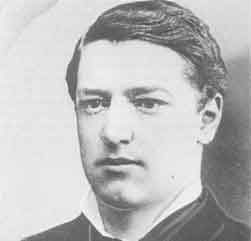 Young WH Taft at Yale William Howard Taft(S&B 1878) is the only man who has served as both President and Chief Justice of the United States.
Young WH Taft at Yale William Howard Taft(S&B 1878) is the only man who has served as both President and Chief Justice of the United States. 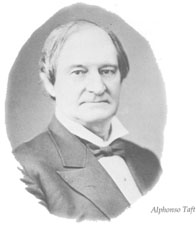 His father, Alphonso Taft (S&B co-founder 1833) was appointed Secretary of War by President Ulysses Grant, and later U.S. Attorney General. As Attorney General, Alphonso helped fashion the commission that decided who won the 1876 election. The commission found in favor of Rutherford B. Hayes, a member of Delta Kappa Epsilon, (DKE), originally a junior secret society at Yale, and the only national Greek letter fraternity initially founded at Yale. In 1882, Alphonso was appointed U.S. Minister to Austria-Hungary. He then moved to Russia for two years, leaving in 1886. He died in 1891. His son, William Howard Taft, appointed by President McKinley, to be the first civil governor of the Philippines, displaced a disgruntled General Arthur MacArthur (General Douglas MacArthur's father) who had been the military governor. Teddy Roosevelt (DKE), who became president after McKinley’s assassination, appointed Taft to serve as Secretary of War (1904-08). While Secretary, he was the "master overseer and troubleshooter" for the Panama Canal; provisional governor of Cuba; and acting Secretary of State, while the Secretary of State John Hay was ill.
His father, Alphonso Taft (S&B co-founder 1833) was appointed Secretary of War by President Ulysses Grant, and later U.S. Attorney General. As Attorney General, Alphonso helped fashion the commission that decided who won the 1876 election. The commission found in favor of Rutherford B. Hayes, a member of Delta Kappa Epsilon, (DKE), originally a junior secret society at Yale, and the only national Greek letter fraternity initially founded at Yale. In 1882, Alphonso was appointed U.S. Minister to Austria-Hungary. He then moved to Russia for two years, leaving in 1886. He died in 1891. His son, William Howard Taft, appointed by President McKinley, to be the first civil governor of the Philippines, displaced a disgruntled General Arthur MacArthur (General Douglas MacArthur's father) who had been the military governor. Teddy Roosevelt (DKE), who became president after McKinley’s assassination, appointed Taft to serve as Secretary of War (1904-08). While Secretary, he was the "master overseer and troubleshooter" for the Panama Canal; provisional governor of Cuba; and acting Secretary of State, while the Secretary of State John Hay was ill. 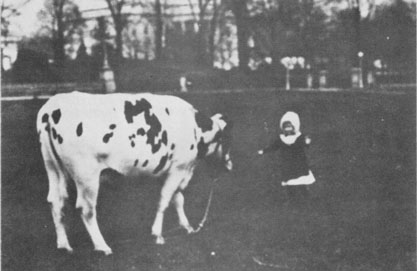
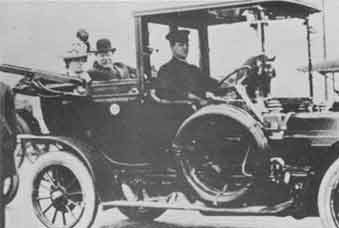
William Taft was elected President of the United States in 1909. He had the last cow and the first official automobile at the White House. During his administration, lawmakers sent Constitutional amendments to the states which provided for the direct election of Senators and a Federal Income tax. The foundation for the Federal Reserve System was laid during Taft’s administration and was signed into law furtively by his successor, Woodrow Wilson on Christmas Eve 1913. W. H. Taft was appointed Chief Justice of the Supreme Court by President Harding in 1921, and served until his death in 1930.
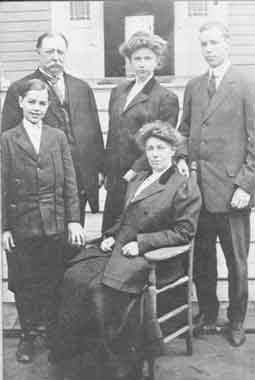 WH Taft and Family, inluding two future S&B members Robert and Charles.
WH Taft and Family, inluding two future S&B members Robert and Charles.
President Taft made Henry L. Stimson (S&B 1888) his Secretary of War (1911-13). Stimson was appointed to high government posts by seven presidents. He was Governor General of the Philippines (1926-1928), Secretary of State under President Herbert Hoover (1929-1933) and Secretary of War under Presidents Franklin Delano Roosevelt and Harry S. Truman (1940-1946). He was "ultimately responsible" for the internment of Japanese-American citizens in WWII and oversaw the Manhattan Project, America’s atomic bomb program. Stimson also took credit for swaying Truman into dropping "the bomb" on Japan. Henry groomed a generation of "cold warriors," in what was known as "Stimson's Kindergarten". Among Stimson’s students were General George C. Marshall, John J. McCloy, Dean Acheson (DKE), three "Bonesmen" from the Bundy family, and Robert A. Lovett (S&B 1918).
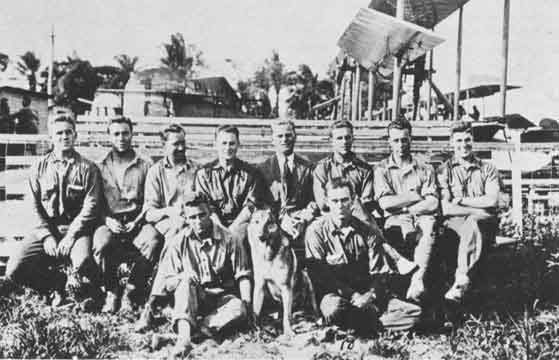 The "Yale Flying Unit"
The "Yale Flying Unit"
Front Row: Wellsey Laud Brown and Henry P. Davison (S&B 1920) Back Row: John Vorys(S&B 1918), Artemus Gates(S&B 1918), Albert Dilman, Jr., Allan Ames(S&B 1918), David McCulloh, F Trubee Davison(S&B 1918), R Lovett(S&B 1918) & E. Gould
Arthur Schlesinger, Jr., wrote, "These men helped establish a distinguished network connecting Wall Street, Washington, worthy foundations and proper clubs. The New York and legal community was the heart of the American Establishment. Its household deities were Henry L. Stimson and Elihu Root* ; its present leaders, Robert A. Lovett and John J. McCloy; its front organizations, the Rockefeller, Ford and Carnegie foundations and the Council on Foreign Relations (CFR). " [* T. Roosevelt's Secretary of War—after W.H. Taft—and Stimson's senior law partner]
Robert A. Lovett was Assistant Secretary of War for Air (1941-1945), Secretary of Defense (1951-53), and a leading member of the CFR. Until his death in 1986, Lovett was one of the "most powerful men in the United States for nearly 40 years." And as a partner in the investment house of Brown Brothers, Harriman, Lovett had connections to another interesting group of "Boodle Boys" ( an old slang term for members of the Order of Skull and Bones.)
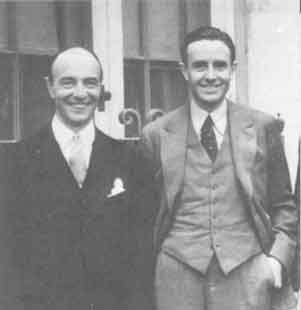
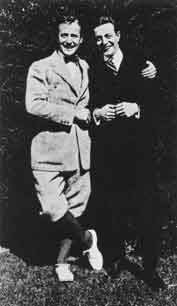
R Lovett and A Harriman in1936 R. Harriman and R. Lovett -1919
The fathers of W. Averell Harriman (S&B 1913) and Lovett were both executives for Union Pacific Railroads. Robert and the Harrimans were childhood friends.
In 1919, Averell Harriman founded WA Harriman and Company, a merchant investment house, now Brown Brothers, Harriman. Harriman took the reins of Union Pacific in 1932 serving as chairman of the board of untill 1942. Averell had a lifelong interest in Russia, first visiting there in 1899. His last visit at age 91 was in 1983. Averell invested in the USSR soon after the revolution in defiance of federal laws and regulations. The investment firms, Guaranty Trust and Brown Brothers, Harriman—both dominated by "Bonesmen"—were involved in the early financing of Communist Russia. They financed industries, established banks and developed oil and mineral resources. Later, as Minister to Great Britain in charge of Lend-Lease for Britain and Russia, Harriman created a program, that shipped entire factories into Russia and—according to some who were involved in the deal—was responsible for the transfer of nuclear secrets, plutonium and U.S. dollar printing plates to the USSR. 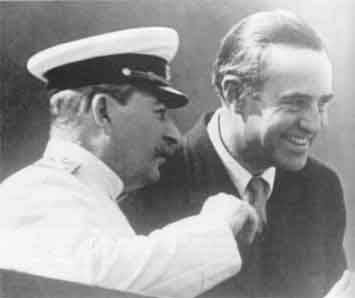 Harriman and Stalin
Harriman and Stalin
Harriman was the US Ambassador to the Soviet Union from 1943 to1946) and was a presidential secret envoy to Soviet leaders Stalin, Krushchev, Brezhnev and Andropov. After World War II, he served as Secretary of Commerce (1946-48), special assistant to President Truman, and the U.S. representative at NATO meetings.
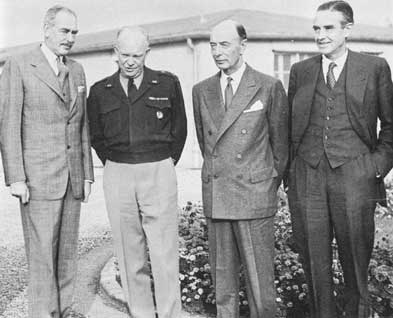 Secretary of State Dean Acheson, Ike, Secretary of Defense R Lovett and Mutual Security Administration Director W. Harriman-11/51
Secretary of State Dean Acheson, Ike, Secretary of Defense R Lovett and Mutual Security Administration Director W. Harriman-11/51
In 1951, Averell became the Director of the Mutual Security Agency. Working with his fellow "Bonesman" Robert Lovett, who was Secretary of Defense and who had chaired the Lovett Committee in 1947, to organize US intelligence activities, they created a framework of national security apparatus belli, with "organization[s] of covert operations and 'psychological warfare.' " 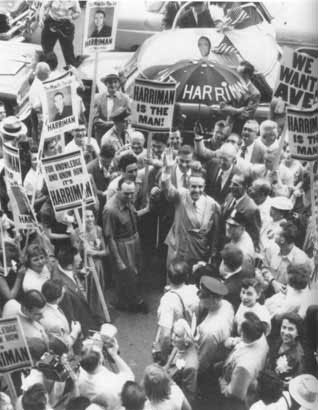
Harriman served a term as the Governor of New York (1954-58) and went on to dominate the Democratic national party as its "elder statesman" for the rest of his life.
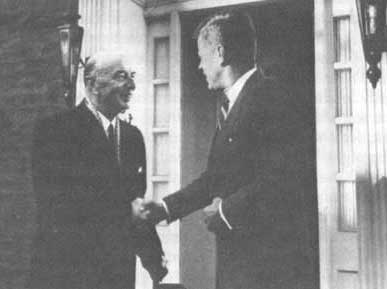
Robert Lovett, was asked by incoming President Kennedy to be Secretary of Defense or Treasury, he declined. But Lovett did suggested his friends, C. Douglas Dillon, investment executive and diplomat; Dean Rusk, Rockefeller Foundation president; and Robert MacNamara of Ford. These three became Treasury Secretary, Secretary of State and Secretary of Defense—the administration's most "important policy making positions"—and some of the "architects of the Vietnam War." 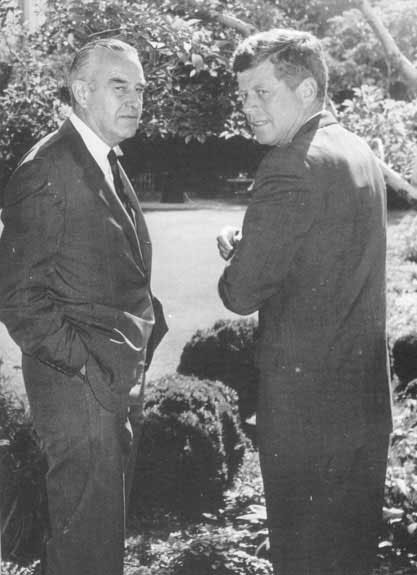
During the Vietnam conflict Harriman served in the State Department as Ambassador at Large for Presidents Kennedy and Johnson. He served as Under Secretary of State for Asia (1961-1963) and Under Secretary of State for Political affairs (1963-65), and led peace negotiations with North Vietnam in 1968. "Stimson's Kindergarten" graduates, William Bundy (S&B 1939) and his brother McGeorge Bundy (S&B 1940), from their positions in the CIA, Department of Defense, the State Department and as Special Assistants to Presidents Kennedy and Johnson, exercised significant impact on the flow of information and intelligence during the Vietnam "police action." William Bundy went on to be editor of Foreign Affairs, the influential quarterly of the Council on Foreign Relations (CFR). McGeorge became president of the Ford Foundation. Two partners of WA Harriman and Co.' were Prescott Bush (S&B 1917) and his father-in-law, George Herbert "Bert" Walker. There were many other "Bones" directors and partners, including three from Prescott's class of 1917. Bert Walker inherited a St. Louis dry-goods import and wholesale business. In 1900, he a started a banking and investment firm named the GH Walker and Company. Walker’s family had developed many international banking contacts and he helped organize the 1904 St. Louis World's Fair. A wheeler-dealer, Walker was known as the "power behind the throne" in local Democratic politics. In 1919, Prescott Bush moved to St. Louis after accepting a job offer from Wallace E. Simmons (S&B 1890) in his railroad equipment company. That autumn Prescott met Dorothy, Bert Walker's daughter. That same year, Averell—who needed someone with strong international financial dealings—implored upon Bert to organize The WA Harriman & Co. Averell's brother, Roland "Bunny" Harriman (S&B 1917), was co-owner. Percy Rockefeller (S&B 1904) was a founding financial sponsor and director. Prescott and his young family went to Connecticut in 1925,where he worked at the Harriman-controlled US Rubber Corp. Then, in 1926, his father-in-law Bert, president of WA Harriman & Company, made Prescott a vice-president. After the firm merged with Brown Brothers and became Brown Brothers, Harriman, Prescott was the managing partner. On October 20 of 1942, ten months after Pearl Harbor, the US government ordered the seizure of "all the capital stock of the Union Banking Corporation, a New York corporation," by the US Alien Property Custodian. The government order stated "all of which shares are held for the benefit of … members of the Thyssen family, [and] is property of nationals … of a designated enemy country…" Prescott was a director and shareholder in the bank. Averell, Bert and Prescott—using Union Banking, the Hamburg-Amerika Line and other fronts and holding companies—were directly involved in the build-up of Nazi Germany. Corporate lawyer and diplomat, John Foster Dulles, his brother, OSS and CIA spymaster, Allen Dulles, and others helped supply the Third Reich with capital, financial arrangements and asset management services. This whole arrangement was kept very quiet, marked by only a small notice in the NY Times—years later—on Dec 16, 1944: "The Union Banking Corporation, 39 Broadway, New York has received authority to change its principal place of business to 120 Broadway." No mention was made of the fact that the property had been seized for trading with the enemy, or that 120 Broadway was the Alien Property Custodian's address. And no 'fuss' was made at all, Prescott, later a US Senator, was still a partner in Brown Brothers, Harriman and held directorships for various companies, such as CBS, Dresser Industries, Pan-American Air, Prudential, and U.S. Guaranty and Trust.
 An official signature for Brown Brothers Harriman & Co. c. 1931
An official signature for Brown Brothers Harriman & Co. c. 1931
Some other Skull and Bones partners
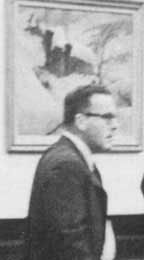
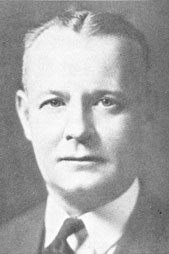
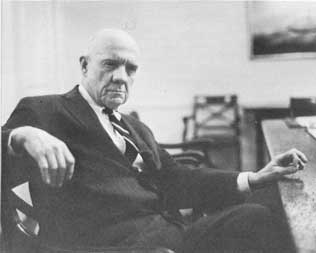 JB Madden S&B1941 Lawernce G. Tighe S&B 1941 Stephen Y Hord S&B1921 Trustee for Russell Treasurer of Yale In charge of Chicago office Trust Assoc
JB Madden S&B1941 Lawernce G. Tighe S&B 1941 Stephen Y Hord S&B1921 Trustee for Russell Treasurer of Yale In charge of Chicago office Trust Assoc
Prescott had another secret, in May of 1918, he and some other "Bonesmen", had stolen Geronimo's skull from the Fort Sill Army Base in Oklahoma. In the fall of 1983, Ned Anderson, Tribal Chairman of the San Carlos Apache Tribe attempted to have the remains of Geronimo returned to his tribe's custody. A newspaper story was written about his search and the Army’s resistance towards his quest. Soon thereafter, an "informant provided Anderson with photographs of the stolen remains, and a copy of a Skull and Bones log book in which a 1918 grave robbery had been recorded. The informant said that Skull and Bones members used the pilfered remains in performing some of their Thursday and Sunday night rituals, with Geronimo's skull sitting out on a table in front of them." " … from a Skull and Bones Society internal history entitled Continuation of the History of Our Order for the Century Celebration, 17 June 1933, by The Little Devil of D'121. "oFrom the war days [W.W. I] also sprang the mad expedition from the School of Fire at Fort Sill, Oklahoma, that brought to the T[omb] its most spectacular "crook,'' the skull of Geronimo the terrible, the Indian Chief who had taken forty-nine white scalps. An expedition in late May, 1918, by members of four Clubs [i.e. four graduating-class years of the Society], Xit D.114, Barebones, Caliban and Dingbat, D.115, S'Mike D.116, and Hellbender D.117, planned with great caution since in the words of one of them: "Six army captains robbing a grave wouldn't look good in the papers.'' The stirring climax was recorded by Hellbender in the Black Book of D.117: "... The ring of pick on stone and thud of earth on earth alone disturbs the peace of the prairie. An axe pried open the iron door of the tomb, and Pat[riarch] Bush entered and started to dig. We dug in turn, each on relief taking a turn on the road as guards.... Finally Pat[riarch] Ellery James turned up a bridle, soon a saddle horn and rotten leathers followed, then wood and then, at the exact bottom of the small round hole, Pat[riarch] James dug deep and pried out the trophy itself.... We quickly closed the grave, shut the door and sped home to Pat[riarch] Mallon's room, where we cleaned the Bones. Pat[riarch] Mallon sat on the floor liberally applying carbolic acid. The Skull was fairly clean, having only some flesh inside and a little hair. I showered and hit the hay ... a happy man....'' After many tries Ned finally met with Jonathan Bush (S&B 1953] brother of then vice-president George Herbert Walker Bush (S&B 1948, DKE) in September 1986. Jonathan told Anderson obliquely "that he would get what he had come after" and said come back tomorrow. Tomorrow never came—the meeting was postponed. "Bones" attorney Endicott Peabody Davison (S&B 1945) of the law firm Winthrop, Stimson, Putnam, and Roberts was called in. After some delay another meeting was held. Davison brought a display case—resembling the one Ned had a photo of—and a skull. The skull was different and appeared to be that of a child. According to a 1988, Washington Post article, lawyer Davison wanted the Apache leader to sign an agreement that disallowed "anyone in association with us to make or permit any publication in connection with this transaction.'' Anderson refused. Davison claimed that "the Order's own history book is a hoax." However during the negotiations with Anderson, Davison never gave up the stipulation that "Anderson give up his copy of the book." Ned refused the proffered skull and signed nothing. The private response from Skull and Bones members is that—if anything at all—Prescott was "conned' into purchasing a fake Geronimo skull and they point to reports of an archivist at Fort Sill who says the grave had been "moved … several years earlier." Prescott's "alleged" skull theft and his "trading with enemy" were unknown publicly and had no bearing when he ran for Senator in 1950, but last minute revelations of his "contacts with birth controllers" … "cost him the election ... " (Yale and many of the Skull & Bones’ family have been at the forefront of the "race-science movement"—a whole story in itself. Yale economist Irving Fisher (S&B 1888), was the founder of the American Eugenics Society.) In 1952, Eisenhower—an avid golfer—was running for President, having beaten Robert Alphonso Taft (S&B 1910) for the Republican nomination amidst fisticuffs and the first fully televised convention. Prescott a past president of the United States Golf Association was one of Ike's favorite golfing partners. Prescott's father-in-law, Bert, had also served as president of the USGA and in 1922, initiated an amateur golf tournament between the United States and Great Britain and Ireland. Walker donated the trophy and the newspapers christened it the "Walker Cup." Prescott Bush won a special election—with Ike's help—in 1952, and became the senior US Senator from Connecticut. He served on the Armed Services Committee and helped to keep Connecticut’s huge defense contractors busy.
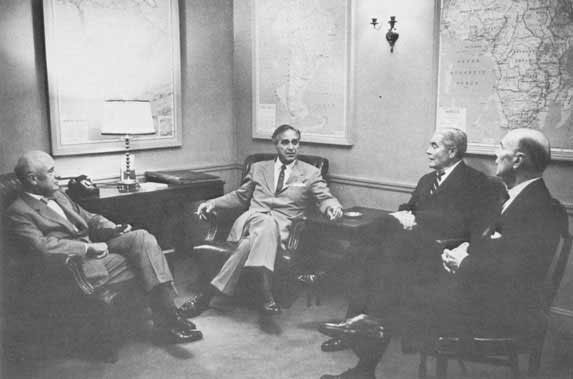 Roland Harriman, Prescott Bush, Knight Woolley and R. Lovett - all S&B and senior Partners at Brown Brothers Harriman - 7/64
Roland Harriman, Prescott Bush, Knight Woolley and R. Lovett - all S&B and senior Partners at Brown Brothers Harriman - 7/64
Leaving the Senate, in 1962, Prescott rejoined Brown Brothers, Harriman and stayed involved in his family's business, political and social life. He was very instrumental in his son's business and political careers. He passed away in 1972, before he saw his son George Herbert Walker Bush elected to be the second US president from the foreign-based secret society, the Order of Skull and Bones. But there was more to Prescott than meets the resume. Prescott Bush had been an operative for Army Intelligence during World War I. He was a liaison to the British and some say he was trained by famous Stewart Menzies, WWII head of the British secret service. Gordon Gray (another one of Prescott's golfing partners) was the first director of the Psychological Strategy Board, having been installed by the "Harriman security regime" in the early 50's. Gray and his four elite Jupiter Island, Florida, neighbors Prescott Bush, Robert A. Lovett, C. Douglas Dillion and "Jock" Whitney, are, along the Dulles and Harriman brothers considered by some historians to be the "fathers of this permanent covert action monolith". The "secret government" in the shadowy realms of intelligence operations that cloaks its actions with cries of national security. They created this modern wall of deniality for Eisenhower deep within the government-military-industrial complex—that Ike was later to regret. One of Gray's jobs, as Ike's National Security advisor, was "under the guise of 'oversight' on all US covert action, to protect and hide" the "cryptocracy." "Gray's son, C. Bowden was President Bush's very helpful "soulmate'", "protector of the president, come what may", White House counsel. He helped to keep George "out of the loop," as George became embroiled in the evolving Iran-Contra scandal.
In 1954, H. S. Richardson, the maker of Vick's cough drops and Vapo-Rub, wrote in a letter to Senator Prescott Bush; "… I want to get your advice and counsel on a subject—namely what should be done with the income from a foundation, which my brothers and I are setting up…" Eugene Stetson (S&B 1934), an assistant manager for Prescott Bush at Brown Brothers, Harrimans organized the H. Smith Richardson Foundation. The foundation participated in the MK-ULTRA, a CIA domestic covert psychological warfare operation and helped to finance the testing of psychotropic drugs, including LSD, at Bridgewater Hospital in Massachusetts in the 50's. During the Iran-Contra operations, the H. Smith Richardson Foundation was a "private donors steering committee," working with the National Security Council to co-ordinate the Office of Public Diplomacy. This was an effort to propagandize the public in favor of and run cover for the Iran-Contra operations, and to coordinate published attacks on opponents of the program. In 1962, Prescott founded the National Strategy Information Center, with his son, Prescott Bush, Jr. and William Casey, investment banker, OSS veteran —and future CIA director. The center, among other things, laundered funds for the dissemination of "CIA authored 'news stories' to some 300 newspapers."
Iran-Contra, Watergate are just two of the many scandals that allows glimpses into a "secret government" netherworld. Scandals used to deflect attention away from deeper corruption. A black and gray world where one sees many of the same faces and, yes, George HW Bush is/was in the loop. A deep cover in an alliance of oil and intelligence that has merged with another cabal—intelligence, the mob and drugs. "Drug trafficking" is now in the realm of "national security." There are excuses like—isn't it better that we do it, instead of someone else, and other spurious—whatever's handy hoodwinks and backstops. Here, one is dealing with an "intel" world where a big rule is to leave no fingerprints. Deniability—being out of the loop— are built into systems of overlapping agencies and groups that are used by this "secret government." The assault upon the rights of American public through an unconstitutional War on Drugs has just been part of a directed cultural, economic, political and real warfare. There is no true public debate or public exposure. ABC's Peter Jennings does series of reports on CIA's shady money dealings—ABC is bought by Bush friend William Casey's influenced Capitol Cities—and the reports stop. Many a policing agency's bust is "compromised" by claims of national security; money and property are given back and get-out-of-jail-cards are routinely used—while us hoi polloi's lives are ruined. Exposes, reporters and agents are summarily squashed, ignored, dismissed, jailed and … killed. A steady drumbeat of events and news stories is used to create fear and division within our society. The targeted racial realities and exploited fears of the drug trade and drug use are used to subdue many and disenfranchise all parts of the community. Along with the crack, came the reality-cop show "popularizing the police state." More laws, equals more criminals, more prisons, more controls and more corruption. And more money to be made … Prohibition brings higher prices. Competition can be "officially" weeded out and the public pays for anti-drug messages that entreats teens. Drugs are a hard-metal cash crop. "Gold" from the ground—in some places it can be harvested three times a year. Drugs … is the biggest business on the planet. But then, this game is not new and has been played before …
The Charmer, China Trade Clipper Ship launched 1854
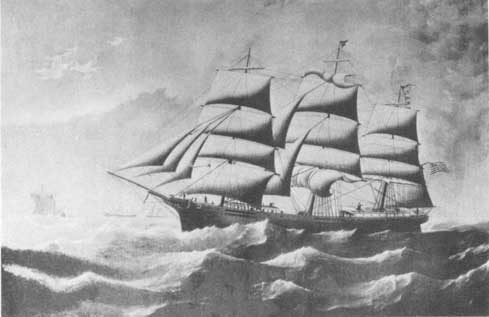 The Charmer was built in Newburyport, Massachusetts by Geo. W. Jackman for Bush & Wildes of Boston.
The Charmer was built in Newburyport, Massachusetts by Geo. W. Jackman for Bush & Wildes of Boston.
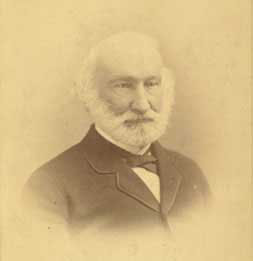 Col. WH Russell in his later years
Col. WH Russell in his later years
William H. Russell (Skull &Bones; co-founder-1833) cousin Samuel Russell formally established Russell & Co. on January 1, 1824 for the purpose of acquiring opium and smuggling it to China. Russell & Co. merged with the number one US trader, the J. & T.H. Perkins "Boston Concern" in 1829. By the mid-1830s the opium trade had become "the largest commerce of its time in any single commodity, anywhere in the world." Russell & Co. and the Scotch firm Jardine-Matheson, then the world's largest opium dealer working together were known as the "Combination." George HW Bush (S&B 1948) was born in Milton, Massachusetts not far from the historic home of Robert Bennett Forbes, a Russell partner. Many great American, European and Chinese family fortunes were built on the "China"(opium) trade. Yes, they sold porcelain, tea, silks and other items at home in the US, but they "needed" the trade in opium for silver to pay for the desired goods and—opium smuggling returned "handsome" profits 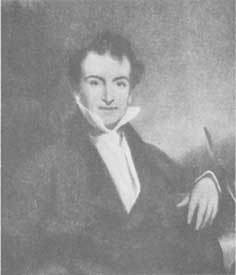 Samuel Russell of Middleton, Connecticut
Samuel Russell of Middleton, Connecticut
Opium smuggling didn’t just make money. At times, opium was money. Opium built empires and had a hand in financing much of the world’s infrastructure.
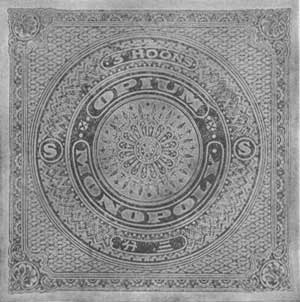
Wrapper for opium packet. Singapore c.1920
From Carl A Trocki’s excellent book, Opium, Empire and the Global Economy(1999): "The trade in such drugs usually results in some form of monopoly which not only centralizes the drug traffic, but also restructures much of the affiliated social and economic terrain in the process. In particular two major effects are the creation of mass markets and the generation of enormous, in fact unprecedented, cash flows. The existence of monopoly results in the concentrated accumulation of vast pools of wealth. The accumulations of wealth created by a succession of historic drug trades have been among the primary foundations of global capitalism and the modern nation-state itself. Indeed, it may be argued that the entire rise of the west, from 1500 to 1900, depended on a series of drug trades." <> ". . . the image of the "opium empire," a metaphor first offered by Joseph Conrad. It takes up the early history of opium and other "traditional drugs" such as tobacco and sugar and develops the paradigm of commercialized drug trades and ties that to the growth of European colonialism in the Americas and Asia . . ." <> ". . . links between drug trades, European colonial expansion, the creation of the global capitalist system and the creation of the modern state. Drug trades destabilized existing societies not merely because they destroyed individual human beings but also, and perhaps more importantly, because they have the power to undercut the existing political economy of any state. They have created new forms of capital; and they have redistributed wealth in radically new ways." <> "Opium thus created a succession of new political and economic orders in Asia during the past two centuries. These included the state of the East India Company itself, the new Malay polities of island Southeast Asia, the colonial states of nineteenth-century Southeast Asia and the warlord regimes of post-Qing China as well as the Guomindang and communist states that arose out of that milieu. At the same time, the economies of the entire region were radically reoriented, or perhaps "re-occidented" would be a more appropriate word. India's opium production was brought under western control while China's domestic economy was opened to the west. Southeast Asia was first opened to western traders and then to western control. With the migration of Chinese labor, Southeast Asian economies were transformed into commodity-producing regimes focused on exporting to the industrializing western Powers. Underlying all of this, opium rearranged the domestic economies and pushed them down the path of mass consumption, which together with mass production, typified the "modern" economic order. It is possible to suggest a hypothesis that mass consumption, as it exists in modern society, began with drug addiction. And, beyond that, addiction began with a drug-as-commodity. Something was necessary to prime the pump, as it were, to initiate the cycles of production, consumption and accumulation that we identify with capitalism. Opium was the catalyst of the consumer market, the money economy and even of capitalist production itself in nineteenth-century Asia. <> Opium was the tool of the capitalist classes in transforming the peasantry and in monetizing their subsistence lifestyles. Opium created pools of capital and fed the institutions that accumulated it: the banking and financial systems, the insurance systems and the transportation and information infrastructures. Those structures and that economy have, in large part, been inherited by the successor nations of the region today." One might say, whomever controls opium—controls . . . And it is especially profitable when its illegal, plus the corrupting side-effects that can be "played" towards . . .
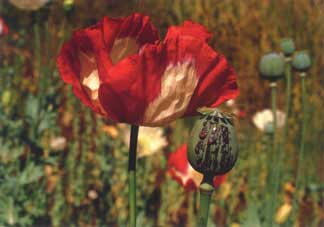
The Opium Poppy O just, subtle, and all-conquering opium! --Thomas De Quincey Confessions of an English Opium-Eater Who first discovered the opium poppy’s attributes is lost in the depths of time. Research suggests that "there are no truly wild" opium poppies and all extant species are cultivars. Opium poppy’s "genetic alterations"—along with a just few other drug and food plants—"imply that the plant is the product of an extensive and sophisticated process of primitive genetic engineering." The basic litany of opium’s history is that cultivated opium seeds and pods have been found at Neolithic sites in central Europe from the fourth millennia B.C. and the plant spread to the south and southeast. Over 5000 years ago, Sumerians were growing opium poppies—the "joy plant"— for both its medicinal and "narcotic" properties. The Assyrians—who called it "lion fat"—assimilated opium use from the Sumerians. The Assyrians passed its use on to the Babylonians, who engendered opium use among the Egyptians. Here use flowered with a unique "thebiacum" strain being developed. A strain with a high amount of thebaine—one of opium's 24 alkaloids—very medicinal but not as soporific. Many classical Egyptian royal tombs were "decorated with paintings of opium poppies" among other medicinal plants. Ancient Egyptian texts included an opiate preparation "Remedy to Prevent the Excessive Crying of Children"—a use carried through many cultures up through the patent medicines sold in America, Britain and elsewhere until the early 1900s. The Egyptians engaged in a strong trade with their strong medicinal variant throughout the Mediterranean. From two Mediterranean isles, comes the only archeological evidence of the smoking of opium before the sixteenth century A.D. The "Peoples of the Sea" on Cyprus were smoking opium in ceramic pipes and were using slashing culling knives on opium pods before 1100 BC. From "primordial opium dens" and other sites on Crete, archaeologists have uncovered sophisticated smoking devices, very similar to ones devised by the Chinese 3,000 years later and—a most amazing statue.
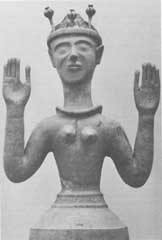
"The Poppy Goddess, Patroness of Healing" is about three feet high with three poppies in the front of her tiara. Some "archeologists speculate that this female deity, crowned with poppy pods, presided over an opium-smoking cult on Crete over 3,5000 years ago."
The Greeks looked to opium as both a medicine and a magical talisman within their mythos—a "sacred plant to which were consecrated altars and priests." Then circa 600 B.C. the Greek culture began transforming from one of magic and myth to one encouraging reason and the study of knowledge. One of the big changes was from choosing of a pharmakos—a sacrificial human scapegoat, to be stoned to death—towards a cult of doctor-priests gathered around the legend of Aesuclapius. They were known to give their patients an admittance exam consisting of an opiated potion accompanied by sleep on a freshly-skinned rams skin. After the patients slept they were queried about their dreams for a prognosis and diagnosis. Hipocrates was born near the Aesuclapisian main hospital on the isle of Cos in 460 B.C. Hipocrates stripped away the magic to become the father of medicine. He showed opium to be "useful as a cathartic, hypnotic, narcotic and styptic" and bespoke of monitored moderate usage. The Aesuclapisians were the medical establishment all through the Roman era. The isle of Cos was a favorite rehabilitation clinic for Nero, who had been enthroned with help of another use of opium—a poison. His mother Agrippina put opium "in the wine of her fourteen year-old stepson, Britannicus." The dissolution of the Roman European empire into the Dark ages left it to the Crusaders to bring back to Europe familiarity of the drug and its uses from the Arabs. "Healing" in medieval European took many forms, not all being medicinal. The all-powerful church declared that disease was demonic and exorcisms were prescribed. The Arab physicians, the midwives/herbalists and a classical-based school started by Muslim physicians at Salermo on Sicily were the ones that understood and used opium. The "kill-cure Frankish system"—one of leeches, bleeding, blistering, trepanning—"known in its time as Heroic medicine," (ironically some say the root of the word heroin) didn’t generally prescribe opium, decrying it as "lazy." In the first part of the 1500s Theophrastus Bombastus von Hoheheim, otherwise know as Paraclesus created the famous opiated potion, laudanum. Laudanum has come to be a generic term for a variety of oral opiate preparations. When laudanum is made to Paraclesus’s original recipe using orange and lemon juice, one gets a primitive form of heroin. Laudanum-named preparations were a staple medicine used by medical doctors up through the early decades of the twentieth century. Although a tussle between herbalists and medical practitioners continued, the medical establishment embraced laudanum and other opiate preparations for pain relief and their effect of masking the symptoms of disease.
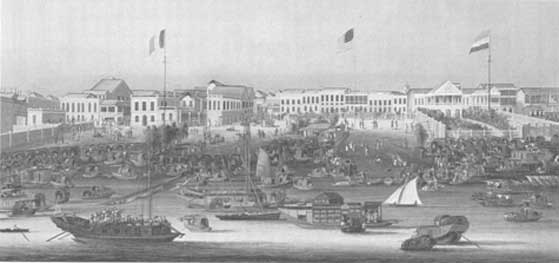
Foreign Factories at Canton 1830-1840, Sunqua
The Opium Trade "If the trade is ever legalized, it will cease to be profitable from that time. The more difficulties that attend it, the better for you and us." -- Directors of Jardine-Matheson The Portuguese arrived in China in the early 1500s and after an abortive attempt to settle near latter-day Hong Kong they were permitted to establish a trading base at Macao in 1557. They brought the first European traded opium to China from their colony of Goa. Arab traders had been bringing in opium ever since around 400 A. D. There was already some domestic production for medicinal uses, opium poppies having reached China some 300 years earlier. The trade had become steady—mainly medicinal—about 200 chests a year until the advent of the Europeans. The era of royal-chartered mercantilist enterprises was afloat and as the Portuguese influence in the East began to wane—there was a rush to fill the void. The Dutch, English and French each began large "corporate" ventures into the "spice" trade. There was also trade interests by other European nations plus Russian, Armenian, Jewish, Parsee and American merchants. The opium trade sparked when the smoking of opium was "introduced." Sailors in the tropics—some for a medicinal benefit against tropical maladies—began to mix opium with their tobacco in their pipes in the late 1500s. This was picked up by various populations and developed into its own subculture. Soon there was the dropping of the mixing with tobacco to a prepared opium smoke(chandu). And special pipes—very similar to ones used on Crete several thousand of years earlier. The Dutch began trading opium in the 1610s, and not just as a profitable trade item. They used opium "as a useful means for breaking the moral resistance of Indonesians who opposed the introduction of their[Dutch] semi-servile but immensely profitable plantation system." In 1689, the English began trading at Canton and by the early 1770's they surpassed the Portuguese, Dutch and French to "became the leading supplier" to China. Because the Spaniards were allies of the America during the US War of Independence and thus no Spanish silver was available to pay for Chinese tea, the British monopolized the source of opium (India) and became the major trafficker. Later, increased competition and the hard facts that a tenth of the British tax base came from tea—and the tea came from China—gave an impetus for an increase in production and reduction in price of opium in the 1820s. "In other words; so that the British public could go on drinking their millions of gallons of tea each year, twice as many Chinese opium addicts (and for that matter, British opium addicts) had to be created." At first, it was thought in China that the English were buying the tea and rhubarb in such large quantities because the Chinese believed the British to be a constipated race because of their dietary inclusion of milk products. Many historians discount the American activity in the opium trade, generally concentrating on the British and their mercantilist trading syndicate, the British East India Company. Because of the Navigation Act of 1651, Americans "were not permitted to sail their own ships to the Orient," they were required as colonists and subjects to buy all their Chinese goods in London from the East India Company. The East India Company’s monopoly on the tea trade was more of a reason for the American Revolution than the cost of the tax. Through a political arrangement the tea was actually coming in for less than it could be bought in England. But the agitation of Samuel Adams, Ben Franklin and others had led to situation where ships were sent back to England unloaded, some cargoes rotted other shipments were destroyed—ala, the Boston Tea Party. American smugglers, many of them prominent merchants, were already buying tea and Chinese merchandise from the Dutch and others. Smuggling was big business. The actual "tea tax" paid officially some years was very low in relation to tea that was drank. After the revolution, Americans were free to embark on their own mercantile adventures and when the East India Company outlawed their own ships from carrying opium, in 1805, American companies jumped right in. The War of 1812 caused some interruption of the trade but after the war the Americans held a major portion of the trade for many years. The first US ship in the China Trade was the Boston sloop Harriet; it had traded American ginseng for Chinese tea. It didn't even get all they way to China, it traded its goods off the Cape of Good Hope. The Empress of China was especially built for the trade by Philadelphia's Robert Morris and first set sail towards China on Washington's birthday, February 22, 1784. It took ginseng and brought back teas, spices, silks, porcelains and other general household goods. There was interest in the products, a good profit was made and the China trade was off and running. Ginseng, seal and sea otter furs, and sandalwood were used to trade with the Chinese. Soon these resources were depleted and a new barter item was needed in lieu of silver—which the fledgling US had little of. In the late 1790's Smyrna (Izmer, today), Turkey a major source for opium began to become port of call for Americans. Until 1792 part of the Perkins family shipping business, along with their Cabot relations was the slave trade. In 1789 Thomas H. Perkins first went to China with Elias Derby from Salem, Massachusetts. A "loyalist" cousin, who fled America during the War of Independence, George Perkins was a merchant in Symrna. With a solid "connection," a strong family framework and firm financial backing Perkins & Company became the leader in the American pack. It was a family affair. Thomas H. was brother-in-law of Russell Sturgis, an uncle to J.P. Cushing and brothers John M. and Robert B. Forbes. Joshua Bates, a partner in Baring Brothers Bank, handled the family business in London. He was married to a Sturgis. Russell Sturgis's grandson later became Chairman of the Board of Barings. Perkins & Co. found that illegality both in nature and operation discouraged competition and used sporadic attempts by the Chinese Government to enforce their opium prohibition, "to [build] the machinery that allowed it to control the Canton market for Turkish opium." Perkins & Company became the first American firm to operate a "storeship" at Lintin in a new smuggling procedure. The opium was unloaded onto the "storeship," then the trading vessel would travel on to Canton with chits. The chits were then sold and the opium was retrieved later by the Chinese buyer. Smooth as silk—all illegal—but bribes were paid and business was good.
Samuel Russell and Phillip Ammidon came to Canton in 1824, Russell having first been there in 1818 as a business representative for a merchant house out of Providence R.I. Ammidon went on to India to serve as the firm's opium buyer. In "a series of accidents and coincidental decisions" Russell & Company acquired a "virtual" monopoly on the American portion of the trade in the 1830's. Other eastern merchants failed, died, or retired like John Jacob Astor. Perkins & Company, resident partner in Canton, Thomas T. Forbes was drown in August of 1829, and he carried a letter which gave Russell "charge of the firm's [Perkin's] business." In the 1830's the price of opium went down and shipments of opium to China went up. The decade started out with four times the shipments of 1820 and by 1838 over ten times. The opium clipper—introduced by the Americans—with its ability to sail against the monsoons made three round-trip journeys within one year instead of taking up to two years. Profits were huge and there was a large flow of silver being introduced from China into booming western economies. In early 1837 there was a price-crash in the opium market and the speculators losses reverberated around the world in a financial panic in which specie became scarce both in Britain and the US. August Belmont came to New York City in 1837, a stopover on his way to Havana, but stayed on in Gotham, buying securities, debts and property during the "Panic of 1837." Many say he was acting as an agent for the Rothschilds. Also in 1837 George Peabody, an old "China" trader—among other ventures—settled in London and brought into his sphere JS Morgan, progenitor of JP Morgan. Many Bonesmen were partners and principals in Morgan-related firms.
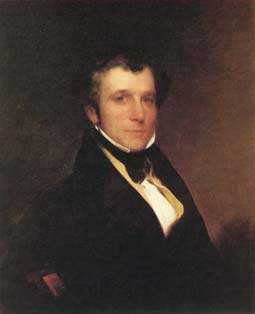
Robert Bennet Forbes (1804-1889) c. 1846
In Robert B. Forbes's autobiography Personal Reminiscences (1882), he talks about talking a trip to visit "constituents" in Europe, in 1841. His uncle, merchant T.H. Perkins went with him. In London they met with Forbes, Forbes and Co, Barings and the Rothschilds, "who were valuable constituents of Russell & Co." That RB Forbes was obliged to go back to China to make another "opium" fortune—having lost his last because of financial problems brought about by the panic—is to say the least— ironic. The "Combination", Russell & Company and the Scotch firm Jardine-Matheson, the largest opium trader, together developed a new trade up and down the China coast—the romantic opium clipper—and helped to spread the use of the opium further in China. After the first "Opium War" Russell & Co. became the third largest dealer in opium in the world.
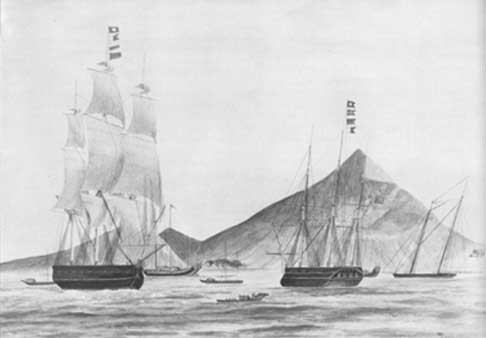
RB Forbes spent many years at the opium smuggling station off Lintin Island c. 1830s Anon.
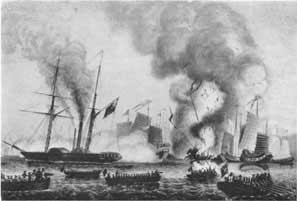
British engaging the Chinese January 1841
The Opium Wars
I had not come to China for health or pleasure, and that I should remain at my post as long as I could sell a yard of cloth or buy a pound of tea. --RB Forbes to Capt. C Elliot, British Superintendent of Trade in refusing to leave Canton during the 1st Opium War Relations between the West and the China has always been strained. There was little from the West that the Chinese wished to buy and their emperor would only receive ambassadors as if they were tribute bearing vassals. Also in the highly structured Chinese social caste, merchants were very low and were not worthy of respect, let alone discourse at an official level. For many years dealings with Westerners were delegated to a few "Hong" merchants who paid for the "privilege" and had to vouchsafe their commercial dealings with the "white devils." High Commissioner Lin Tse-hsu came to Canton in 1839 with an order to "investigate the port affairs." The first edict against opium had come in 1729; another against smoking came in 1796. The trade had grown to 40,000 chests and growing by 1838. The novel, more soporific and addictive manner of smoking opium plus the encouragement of the trade by the British and others—for both economic and imperialistic motives—devastated all segments of Chinese society. Corruption and smuggling was rampant, creating apathy; and the opium trade was also draining China's treasury.
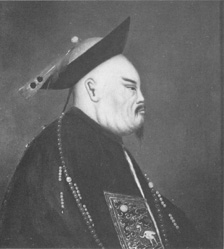 Comissioner Lin Tse-hsu c. 1850 anon.
Comissioner Lin Tse-hsu c. 1850 anon.
Lin couldn't believe that opium was legal in Britain and wrote a letter to Queen Victoria to implore her aid in stopping the trade. He disrupted the local merchants and published new edicts against the use and importation of the drug. Lin demanded that all chests of opium be forfeit as contraband and all trading houses sign a bond, pledge to smuggle no more and become liable to Chinese law which included the death penalty. Through threats, a servant walkout, giant gongs that were rung all-night and other measures, Lin was able to collect over 20,000 chest of opium (about half of that year's Indian trade). Then under orders from the emperor, he destroyed it all. This conflagration sparked the first Opium War, made huge profits for those firms that had held on to chests and left Russell & Company the only trading firm left open in Canton. During that first Opium War, the Chief of Operations for Russell & Co. in Canton was Warren Delano, Jr., grandfather of Franklin Roosevelt. He was also the US vice-consul and once wrote home, "The High officers of the [Chinese] Government have not only connived at the trade, but the Governor and other officers of the province have bought the drug and have taken it from the stationed ships … in their own Government boats."
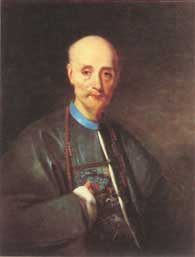
Wu Ping-chen or Howqua II, the leading "hong" merchant—considered by some to be one of the world's richest men at the time—was worth over twenty-six million dollars in 1833.
The trading life started off rather spartan, but through the years many upscale amenities led to a pampered gentry lifestyle. Profits were huge and many fortunes were made. Warren Delano went home with one, lost it and then went back to China to get more. Russell Company partners included John Cleve Green, banker and railroad investor who made large donations to and was a trustee for Princeton; A. Abiel Low a shipbuilder, merchant and railroad owner who backed Columbia University; merchants Augustine Heard and Joseph Coolidge. Coolidge's son organized the United Fruit company, and his grandson, Archibald C. Coolidge, was a co-founder of the Council on Foreign Relations. Partner John M. Forbes "dominated the management" of the Chicago, Burlington and Quincey, with Charles Perkins as President. Other partners and captains included Joseph Taylor Gilman, William Henry King, John Alsop Griswold, Captain Lovett and Captain J. Prescott. Captain Prescott called on his friend and agent in Hong Kong F.T. Bush, Esq. frequently. Russell & Co. and Perkins & Co. families, relations and friends are well represented in the Order of Skull and Bones. After the first Opium War, the port of Shanghai was opened up, with Russell & Co. as one of it first traders, and the Stars and Stripes was the first flag flown in the new concessions. In 1841 Russell & Company brought the first steam ship to the Chinese waters and continued to develop transportation routes—as long as opium made them profitable. They also were invoved with early railroad ventures in China.
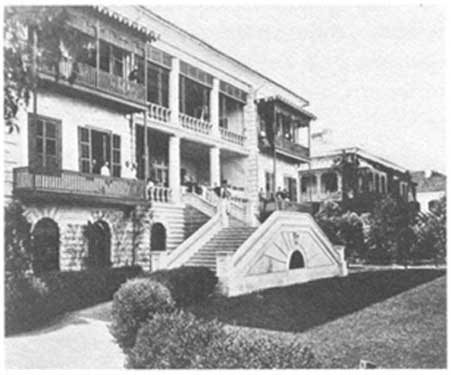
Russell & Co. Shanghai Headquarters c.1890
Spanish traders had joined with American and British traders in the early decades of the 1800s and Manila in the Philippines harbored several trading houses. These were used as offshore support and subterfuges in the opium smuggling dealings and "posturing." The discovery of gold in California brought more dynamics, increased clipper ship activity and a renewed impetus for transcontinental railroads—which were financed a great deal by opium profits from investors in America, Britain and Scotland. The second Opium War led to the legalization of opium in China in 1858 and the "country traders" began to lose their control. They were smugglers warehousing the "product" offshore and trying to control the flow—for maximum profits. Once the product was legalized the Chinese and Indian merchants started to take over the trade. Russell & Co. and others because of their role as smugglers had not developed a structure to sell opium in inner China. The Chinese brokers could now just order opium as any commodity and the trade was transferred to firms with strong ties at the producing base, India, and the consuming behemoth, China. Russell & Co. formed the Shanghai Steam Navigation Company and by 1874 they had 17 steamships—the largest fleet in Shanghai. Russell & Co. sold the Shanghai Steam Navigation Company to the China Merchant’s Steam Navigation Company in 1877 and the American share of Chinese shipping dropped by 80%. Russell & Co. is listed in some sources as failing in 1891 with British and German firms taken over their business. The Chinese Government an associate of Russell & Co. in the coast and ocean trade "lost heavily." According to some, the Russell & Co. successor in Shanghai was Shewan & Tomes.
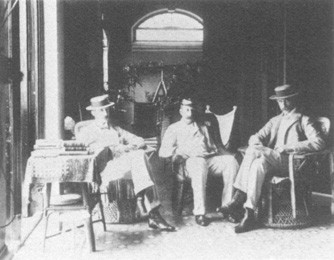
Charles A Tomes[r] and friends, Hong Kong(1896)
The legal opium import trade continued until the early 1920's when an Occidental moral backlash, official regulations and Chinese political turmoil put the trade in the hands of the Chinese government—and Chinese gangs. Out of the turbulence—many years later—came Nationalist Chinese leader Chaing Kai Shek. Some reasons for his success came from the backing he received from the Shanghai's narcotics trafficking Green Gang and his "political manipulation of the narcotics traffic, under the guise of an 'opium suppression campaign, "to finance both a political and an intelligence apparatus." In the early part of twentieth century there were many changes in the opium trade. China and India reached an agreement for cessation of Indian opium imports. By 1920's opium had infiltrated every part of Chinese life, 90% of males in some provinces smoked, morphine was called "Jesus opium" because of its introduction by Western Missionaries as a cure for opium addiction. China was a country divided-up into many different political units with "control" ceded to Japan, America and various European nations. A "prize" from the Spanish-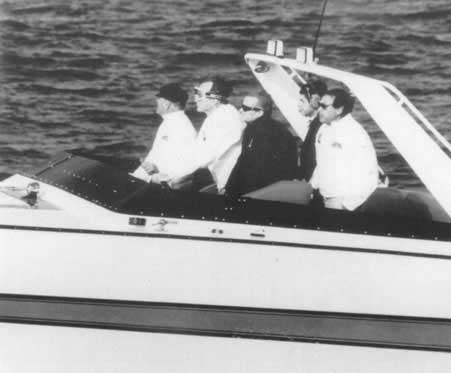 American War, the US had taken control of the Philippines and soon declared opium illegal there. William H. Taft (S&B 1878) had a huge hand in the establishment of US narcotics laws. He exhorted Americans towards the formation of international "narcotics" control and prohibitions. There was also the formalization of an early relationship that Yale University had with China into the Yale-in-China program. Behind these movements one can discern influences of Bonesman such as Anson Phelps Stokes (S&B 1896) and others. Skull and Bones interest and participation in the Philippines is immense. More on these stories later. China was importing massive amounts of heroin from Japan and was officially blaming the Japanese for its problem. Japan did use opiate production both for economic accumulation and as a political tool, especially in Manchuria. But the Chinese heroin trade was larger, by the late thirties over 85% percent of the world's heroin was coming from China headed towards Europe and the Americas. Chinese, Japanese, French Corsican, Arnold Rothestein’s Jewish-American, and Lucky Luciano's American-Sicilian crime syndicates were involved. During WWII, Chiang was fighting both the Japanese and Communist and towards the end of the conflict in the opium dominated province of Yunnan an interesting group converge—the OSS, Chenault's Flying Tiger's and remnants of Chiang's Army, the KMT. Individuals included E. Howard Hunt, Lucien Conein, Mitch Werbel, Ray Clines, William Pawley, Paul Heilwell, Major John Singlaub and others. Which leads us to somemore interesting stories and—interesting Bonesmen.
American War, the US had taken control of the Philippines and soon declared opium illegal there. William H. Taft (S&B 1878) had a huge hand in the establishment of US narcotics laws. He exhorted Americans towards the formation of international "narcotics" control and prohibitions. There was also the formalization of an early relationship that Yale University had with China into the Yale-in-China program. Behind these movements one can discern influences of Bonesman such as Anson Phelps Stokes (S&B 1896) and others. Skull and Bones interest and participation in the Philippines is immense. More on these stories later. China was importing massive amounts of heroin from Japan and was officially blaming the Japanese for its problem. Japan did use opiate production both for economic accumulation and as a political tool, especially in Manchuria. But the Chinese heroin trade was larger, by the late thirties over 85% percent of the world's heroin was coming from China headed towards Europe and the Americas. Chinese, Japanese, French Corsican, Arnold Rothestein’s Jewish-American, and Lucky Luciano's American-Sicilian crime syndicates were involved. During WWII, Chiang was fighting both the Japanese and Communist and towards the end of the conflict in the opium dominated province of Yunnan an interesting group converge—the OSS, Chenault's Flying Tiger's and remnants of Chiang's Army, the KMT. Individuals included E. Howard Hunt, Lucien Conein, Mitch Werbel, Ray Clines, William Pawley, Paul Heilwell, Major John Singlaub and others. Which leads us to somemore interesting stories and—interesting Bonesmen.
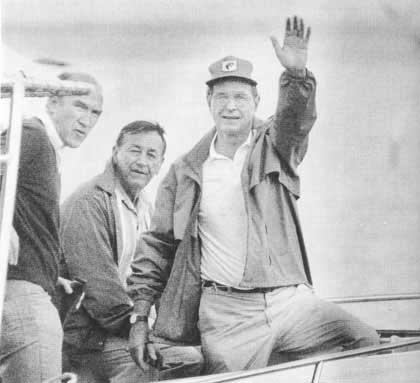
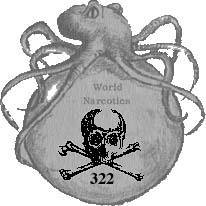
Labels: The Skulland Bones
![[posts.png]](http://4.bp.blogspot.com/_s5yaZ0Ye2Mo/SnVlsPD4ztI/AAAAAAAAVMI/DdB3iDF_krA/s1600/posts.png)
![[th_zionist_legends.jpg]](http://1.bp.blogspot.com/_s5yaZ0Ye2Mo/SnP-kpkRVcI/AAAAAAAAVGw/O9_iOklLt0c/s1600/th_zionist_legends.jpg)
![[150.png]](http://3.bp.blogspot.com/_s5yaZ0Ye2Mo/SnP8CAQNzpI/AAAAAAAAVCg/9e_nTRXTcT8/s1600/150.png)
![[jewisnazi2.png]](http://2.bp.blogspot.com/_s5yaZ0Ye2Mo/SnP8cIWEZyI/AAAAAAAAVDI/QD0hlMGZqjs/s1600/jewisnazi2.png)
![[th_hitler.jpg]](http://2.bp.blogspot.com/_s5yaZ0Ye2Mo/SnP9ppSCdSI/AAAAAAAAVFI/YDXbfd41xSQ/s1600/th_hitler.jpg)
![[th_holocaust.jpg]](http://3.bp.blogspot.com/_s5yaZ0Ye2Mo/SnP9tVLojSI/AAAAAAAAVFQ/8KomH7mP5z8/s1600/th_holocaust.jpg)
![[th_wall_street_hitlert.jpg]](http://2.bp.blogspot.com/_s5yaZ0Ye2Mo/SnP-YvqS7_I/AAAAAAAAVGY/GPF9ACDXNxU/s1600/th_wall_street_hitlert.jpg)
![[th_wallstjewbolshevic.jpg]](http://3.bp.blogspot.com/_s5yaZ0Ye2Mo/SnP-b0WqaHI/AAAAAAAAVGg/JgBcwt0aYIs/s1600/th_wallstjewbolshevic.jpg)
![[th_eustace_mullins.jpg]](http://3.bp.blogspot.com/_s5yaZ0Ye2Mo/SnP9Xdwg3VI/AAAAAAAAVEo/7oufiLeSR6g/s1600/th_eustace_mullins.jpg)
![[th_gary_allen_conspiracy.jpg]](http://1.bp.blogspot.com/_s5yaZ0Ye2Mo/SnP9gqDBbOI/AAAAAAAAVE4/aWpG_k-gJG4/s1600/th_gary_allen_conspiracy.jpg)
![[th_fritz_springmeier_.jpg]](http://3.bp.blogspot.com/_s5yaZ0Ye2Mo/SnP9b41qB0I/AAAAAAAAVEw/TXH3Wa8I-LY/s1600/th_fritz_springmeier_.jpg)
![[th_prtocofmofez.jpg]](http://3.bp.blogspot.com/_s5yaZ0Ye2Mo/SnP996RyCGI/AAAAAAAAVFo/hKrLMRXM18U/s1600/th_prtocofmofez.jpg)
![[th_secret_societies__.jpg]](http://2.bp.blogspot.com/_s5yaZ0Ye2Mo/SnP-QfSPmnI/AAAAAAAAVGI/k0u8WWTMqmA/s1600/th_secret_societies__.jpg)
![[th_archit_of_decep.jpg]](http://2.bp.blogspot.com/_s5yaZ0Ye2Mo/SnP8_Fagd5I/AAAAAAAAVEA/R9AB_TAAkCU/s1600/th_archit_of_decep.jpg)
![[prot1.jpg]](http://2.bp.blogspot.com/_s5yaZ0Ye2Mo/SnP-5NNwKpI/AAAAAAAAVHQ/PzIT2iO8Ils/s1600/prot1.jpg)
![[adlogo.jpg]](http://2.bp.blogspot.com/_s5yaZ0Ye2Mo/SnP_HCi4RiI/AAAAAAAAVHY/h6u1b65b2LY/s1600/adlogo.jpg)
![[th_douglas_reed.jpg]](http://4.bp.blogspot.com/_s5yaZ0Ye2Mo/SnP9SdYdk7I/AAAAAAAAVEg/h1E3you41l4/s1600/th_douglas_reed.jpg)
![[th_life_of_an__am.jpg]](http://3.bp.blogspot.com/_s5yaZ0Ye2Mo/SnP95fjAaPI/AAAAAAAAVFg/bxf6WSpQZjw/s1600/th_life_of_an__am.jpg)
![[th_henry_ford_s.jpg]](http://3.bp.blogspot.com/_s5yaZ0Ye2Mo/SnP9leSMDpI/AAAAAAAAVFA/Wye8WLQAZHo/s1600/th_henry_ford_s.jpg)
![[th_wikipornography.jpg]](http://4.bp.blogspot.com/_s5yaZ0Ye2Mo/SnP-gq7IzyI/AAAAAAAAVGo/h_UbzpZhdzw/s1600/th_wikipornography.jpg)
![[th_roger_garaudy_s.jpg]](http://3.bp.blogspot.com/_s5yaZ0Ye2Mo/SnP-F0UutHI/AAAAAAAAVF4/O02t2JHbkHo/s1600/th_roger_garaudy_s.jpg)
![[th_david_m_pidcock.jpg]](http://2.bp.blogspot.com/_s5yaZ0Ye2Mo/SnP9MLQ8uuI/AAAAAAAAVEY/-isXy9Ng2HA/s1600/th_david_m_pidcock.jpg)
![[th_church.jpg]](http://2.bp.blogspot.com/_s5yaZ0Ye2Mo/SnP9D3lZPEI/AAAAAAAAVEI/eqGoBC4DYrI/s1600/th_church.jpg)

![[th_top_clicks-1.jpg]](http://4.bp.blogspot.com/_s5yaZ0Ye2Mo/SnP-Ul0Io_I/AAAAAAAAVGQ/_XhlFdj_HYk/s1600/th_top_clicks-1.jpg)
![[print.gif]](http://2.bp.blogspot.com/_s5yaZ0Ye2Mo/SnP8osKGJ5I/AAAAAAAAVDg/Y5hArAJiwTo/s1600/print.gif)
![[up.gif]](http://4.bp.blogspot.com/_s5yaZ0Ye2Mo/SnVl4hdOgUI/AAAAAAAAVMY/4TsLm481I-M/s1600/up.gif)
29 Comments:
Close them Down, NOW....
Dave-O
This is the best history lesson I've ever had Thank You.
Well, I do not really imagine this is likely to work.
A great deal of useful information for me!
chenlina20150713
louis vuitton
ray ban outlet
oakley sunglasses wholesale
oakley vault
ray ban sunglasses
ray ban sunglasses
kids lebron james shoes
prada sunglasses
louis vuitton
michael kors outlet online sale
louis vuitton
louis vuitton outlet
michael kors outlet
hollister jeans
christian louboutin sale
christian louboutin outlet
coach outlet online
coach outlet store online
cheap toms
abercrombie and fitch
hollister clothing
cheap jerseys
ed hardy clothing
ray ban glasses
louis vuitton outlet
lululemon outlet
tory burch outlet
christian louboutin shoes
ralph lauren sale
abercrombie
true religion
timberlands
ralph lauren
ray ban sunglasses
oakley sunglasses cheap
jordan 11 snakeskin
cheap jerseys wholesale
ray ban uk
jordan 6 rings
abercrombie store
as
uggs outlet
the north face jackets
louis vuitton handbags
cheap uggs for sale
coach outlet store online
ray ban outlet
michael kors handbags
michael kors handbags
michael kors outlet
ugg boots
ray-ban sunglasses
ugg outlet
michaek kors handbags
michaek kors outlet
oakley sunglasses wholesale
marc jacobs
louis vuitton
louis vuitton handbags
ugg boots for men
gucci handbags
jordans
ugg boots on sale
christian louboutin outlet
ray ban sunglasses
louis vuitton handbags
jordan concords
ray-ban sunglasses
mont blanc pens
michael kors outlet
michael kors outlet
louis vuitton outlet
ugg boots
canada goose outlet
louis vuitton outlet
lebron 12
polo ralph lauren
michael kors outlet
michael kors outlet
ugg boots
cheap jordans
20151226yuanyuan
jordan retro
ray ban uk,cheap ray ban sunglasses
michael kors outlet online
Michael Kors Outlet Store
chrome hearts online
toms outlet store
michael kors handbags
cheap oakleys
mlb jerseys authentic
jordans for cheap
tiffany and co jewellery
discount sunglasses
http://www.chromehearts.com.co
michael kors handbags
michael kors factory outlet
tiffany online
retro jordans
http://www.uggoutlet.uk
kobe byrant shoes
michael kors outlet
Cheap Jordans For Sale
nike kobe sneakers
michael kors handbags
michael kors outlet
tiffany online
mlb jerseys authentic
mlb jerseys authentic
tiffany and co jewellery
fitflops
http://www.outlettiffanyand.co
true religion store
michael kors outlet store
cheap rolex watches
http://www.chromehearts.in.net
fitflops outlet
ray ban sunglasses
huaraches shoes
cheap nfl jerseys
michael kors outlet store
tiffany and co uk
tiffany and co
cheap jordan shoes
michael kors outlet online
michael kors handbags sale
Very Interesting Article.
Oracle dba Training Institute
Cognos Training Institute
Application Packaging Training Institute
CheckPoint Firewall Training Institute
nba jerseys
dolce and gabbana outlet
jets jersey
moncler jackets
bills jerseys
new balance outlet
chicago bears jerseys
nike air force 1
hugo boss sale
nike blazer pas cher
http://www.jordanretro.uk
air max 2016
michael kors outlet
Kanye West shoes
michael kors handbags
nike air zoom
michael kors handbags
af1
adidas neo
michael kors
That is nice article from you , this is informative stuff . Hope more articles from you . I also want to share some information about cognos training
Ah,so beautiful and wonderful post!An opportunity to read a fantastic and imaginary blogs.It gives me lots of pleasure and interest.Thanks for sharing.
Data Science Training In Chennai
Data Science Course In Chennai
Excellent AWS Training in Chennai, from Infycle Technologies, the best software training institute, and Placement centre in Chennai. And also Providing technical courses like Cyber Security, Graphic Design and Animation, Block Security, Java, Cyber Security, Oracle, Python, Big data, Azure, Python, Manual and Automation Testing, DevOps, Medical Coding etc., with the excellence of training and technical trainers for freshers, experienced, and Tech professionals. with 100+ Live Practical Sessions and Real-Time scenarios. And the students will be sent for placement in the core MNC's. For more details call 7504633633 or 7502633633.
Extremely useful case! There is loads of suggestion here that could previously any situation income started further to a well off person to person communication cognizant up assessment. Smartdraw Free Download With Crack
I was examining some of your substance material cruelly this site and that I consider this net page is in actuality educational ! hold while motivation to setting occurring. Imagenomic Portraiture Crack
Extremely nice say. I just found your weblog and expected to communicate that i've for specific valued scrutinizing your weblog posts. After each weakened be purchasing in on your feed and that I dream you form inside a comparable way as again quickly! Best Good Morning Wishes
This is informative stuff . Hope more articles from you . I also want to share some information about Embedded Systems Course in Hyderabad
Your first post was fun to read. Thank you for the post.
mIRC
Your blog was amazing , and really i love your blog
java training in hyderabad
wonderful post thanks for sharing
sql server online training in hyderabad
very nice Article
Dell Boomi is an enterprise iPaaS (integration platform as a service) that helps businesses connect their applications, data, and devices. Dell Boomi training can help you learn how to use Dell Boomi to build and manage integrations.
Dell Boomi offers a variety of training options, including:
Official Dell Boomi training: Dell Boomi offers a variety of official training courses, both online and in-person. These courses are taught by Dell Boomi certified instructors and cover a wide range of topics
great article, thanks for sharing
react js institute in hyderabad
nice blog
thank you for sharing with us.
Nice article
digital marketing course in hyderabad
digital marketing trainier
Nice story, I love your writing style, keep posting more
React JS Training institute in KPHB
"Great article, felt good after reading, worth it.
i would like to read more from you.
keep posting more.
also follow Mern Stack course in hyderabad"
"Top Digital Marketing Agency In Hyderabad
"
Post a Comment
Subscribe to Post Comments [Atom]
<< Home